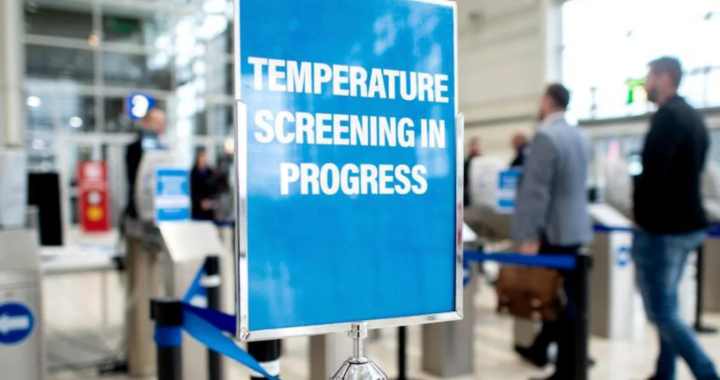The last few months have been a bit of a whirlwind to say the least, who would have thought that when we were all making our 2020 new years resolutions and hoping it was going to be the best year ever, it would turn out to be the complete opposite!
Coronavirus has shaped the way businesses and how the public go about our daily lives into a ‘new normal’. Masks are now mandatory to wear in most places, going on holiday is seen as a risk and just one sick employee can cause the shut down of an entire business.
Already in China, facial recognition with built-in temperature checkers have been rolled out almost everywhere, in places such as businesses, entrances to subway stations, supermarkets and shopping centres. These systems could prove to be vital to ensure that a business can continue to run smoothly without having to worry about having to close due to a COVID outbreak.
Here in England, we are already starting to see pubs and other hospitality businesses having to close due to an employee testing positive for covid. Having temperature checks in place could prove to be beneficial in keeping a business open. However, how reliable are thermal sensors?
How do thermal imaging sensors work?
Thermal imaging sensors work by using infrared technology, detecting heat radiation from the body, most commonly, the forehead, and estimating the core body temperature. Although thermal imaging sensors are beneficial tools to use, they are not intended to be used for medical purposes.
Body Temperature Vs Skin Temperature
Thermal imaging sensors can give an almost accurate measurement of skin temperature but this is different to body temperature. A high temperature is considered to be anything 38C or above for body temperature. Skin temperature can vary from person to person and can change throughout the duration of the day.
Thermal imaging sensors and coronavirus
The World Health Organisation has recently warned that alone, temperature screening “may not be very effective.”
Thermal imaging sensors can not and should not be used by businesses as a sole way of detecting a fever in an employee, given that numerous different factors can play in to why someone’s temperature may be high and they can in no way detect coronavirus. A high temperature is just one symptom of the virus, therefore, the cameras will miss those infected who are displaying other symptoms or are asymptomatic. Body temperature can also be manipulated by other factors, for example, someone who has just recently exercised, ate a large meal or feeling stressed, will have a different body temperature than they did a few hours ago. This gives off a false positive reading.
However, they are still useful to a point in alerting a rise in somebody’s temperature and if it is followed – up by further actions, could be beneficial at keeping illnesses out of the work place.
Weighing up the Pros and Cons of using thermal imaging sensors
Pros
-
Using advanced technology, thermal cameras can detect temperature fast with a high accuracy rating. Most thermal imaging cameras have an accuracy of (≤± 0.5°C (0.9°F))
-
False readings can be minimised, as thermal cameras will only pick up heat radiating from the body, for example, if someone where to be holding a hot drink during their check, this would not manipulate the temperature reading.
-
Businesses that use thermal cameras linked with a Time and Attendance system can save temperature data as event logs, this is useful for tracking and tracing.
-
Businesses can set temperature thresholds, so any employee who tries to enter the workplace and they are above this will be refused entry, an appropriate member of staff can then be alerted and a health assessment should take place.
-
It could help prevent the shut down of an entire business if a covid related temperature is detected, but it should not be used as a sole detection method.
Cons
-
Body temperature is different to skin temperature, causing inaccurate readings.
-
There are many factors which can manipulate skin temperature to make it fluctuate between being high or low, depending on an individual’s recent activity. Such as:
– Exercising can cause the skin to cool down when you sweat.
– Stress or excitement can cause a rise in temperature.
- In order to get the most accurate reading, you need to be a certain distance away from the camera. This could be an issued trying to get employees to stand the correct distance away and some face recognition clocking in systems can be sensitive.
- Some employees could see temperature checks as an invasion of their privacy.
- Some existing health conditions can cause temperatures above 37C and employees may not be willing to disclose this information.
- It can not be used as a way for detecting coronavirus.
So, how well could they work for businesses?
While it is encouraging that good thermal sensors can distinguish a small difference in temperature, it is still only able to measure the surface of the skin. However, this still might be useful information to have and being able to compare people who are warmer than others, could prove to be beneficial in the long run by flagging up those who have high temperatures and following it up with further questioning.
Thermal imaging sensors are a way of screening employees and should not be used as a way of diagnosing illness. Which does not make them totally pointless for businesses to use. They are a quick, non-invasive and inexpensive tool to have to keep track of employees.
Let us know what you think about introducing thermal temperature sensors to your workplace! We would love to hear your views. https://www.permatek.co.uk/general-enquiry/


